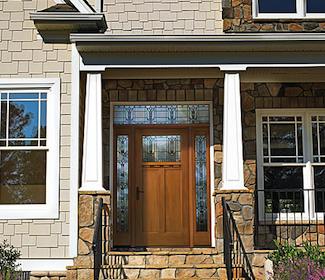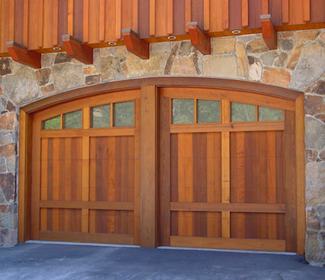Energy Efficient Doors

Therma Tru Doors for Entrances
When designing your green home, it's important to not forget about doors. Doors often get overlooked, with more attention paid to other items such as windows, siding, and roofing materials. But an exterior door that's not insulated or installed correctly can be a large source of energy loss in your home.
Exterior Energy Efficient Doors
Exterior doors need to be made of durable materials to stand up to extreme weather conditions: rain, hail, snow, and the heat and UV rays of the sun. Most exterior doors are made of solid wood or insulating foam wrapped in metal or another weather-resistant material like fiberglass.
What to Look For in Energy Efficient Doors
Wood Exterior Doors If you are choosing a solid wood door, the main thing to look for is the FSC-certified label. The Forest Stewardship Council standard for wood includes third-party evaluation and monitoring of sustainable forestry practices. FSC-certified wood promotes long-term sustainable forest management for the benefit of forest ecosystems, timber resources, and local economies.
An even more environmentally-sustainable wood door is one that has been reclaimed. Reclaimed wood products do not have the environmental burdens that come from timber harvesting. Using reclaimed wood re-milled into wood doors can provide colors, textures, and beauty today's faster growing, younger wood can't offer.
Wood doors, however, are not the most energy-efficient choice for your home's exterior.

Energy Efficient Doors - Andersen Entrance Systems
The use of low-e glass can greatly increase the r-value of new windows. Low-e glass contains invisible layers of special coatings, typically tin dioxides or thin silver layers. These coatings reflect radiant energy, keeping that heat on the same side of the glass from which it originated, while still letting visible light pass.
During hot periods, the heat (and UV rays) of the sun is reflected away, lowering cooling costs. On the flip side, during cooler months, the low-e window keeps heated air on the inside of the house, lowering heating costs.
The premium price of low-e windows, usually 10-20% higher than traditional windows, will pay for itself in just a few years in energy savings.
Composite Energy Efficient Doors with Foam Insulation Core
Exterior doors made from steel, fiberglass, or other composite materials, around a foam insulation core, are far more energy efficient than solid wood doors.
Due to a competitive market, most insulated doors have similar levels of energy efficiency. Most insulated doors will have insulating values of R-5 to R-7. The higher the R value, the most efficient the door will be.
To ensure your insulated door is as energy efficient as possible, be sure to look for the Energy Star label. This label ensures that the door meets strict guidelines for efficiency to save you the most energy and money. An Energy Star-certified exterior door will reduce energy usage, and its carbon footprint, by 7 to 15% more efficient than a non-rated door.
It's also important that the foam insulated exterior door uses a foam that is CFC-free to avoid any ozone depleting chemicals. Most doors today do use CFC-free foam, but it's still important to check, just to be sure.
Installation is Important!
Any exterior door, regardless of what it's made of, will benefit greatly from quality weather-stripping and thresholds. The proper installation of the door, including the weather stripping, is critical to the door's energy-efficiency. Improperly installed, or installed with inadequate weather stripping, will allow air to enter (and exit) the home, contributing to drafts and higher heating and cooling costs.

Energy Efficient Doors - Carriage House Door Company
Interior Doors
Energy efficiency isn't as important to interior doors as it is to exterior doors, but there are some things to look for in an interior door. Quality, and costs, of interior doors can vary greatly.
Solid wood doors are beautiful, completely natural, minimally-processed, and provide a high level of sound insulation. However, they are quite expensive, and clear stock that doesn't come from old-growth forests is getting harder to find.
Most interior doors are made from molded hardboard. Lauan plywood, a popular choice for interior doors, comes from a non-sustainable harvested rainforest wood, and should be avoided at all costs.
Molded hardboard is typically made with some recycled materials, often scraps from wood mills. Any hardboard that is made with urea-formaldehyde should be avoided, since formaldehyde is highly toxic and a common indoor air pollutant.
As with exterior doors, you should seek out interior doors made from FSC-certified wood. If you choose interior doors with foam cores (often used for sound-proofing), make sure the foam is CFC-free.
comments powered by Disqus

























































































































































































